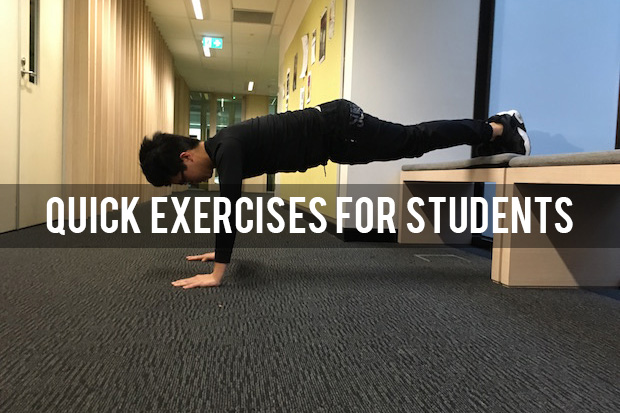Four exercises for students who are short on time
WORKING out can be time-consuming but have no fear! Trinity College Foundation Studies students Johan Firmansyah Cheah, Yanming Lei and Junyuan Chen demonstrate some quick and easy exercise routines for students who are time and equipment deficient.
Most people who don’t get enough exercise either blame it on their busy schedule, or admit that they prefer spending their time on something else. Others have a tendency to stay up into the wee hours of the morning either by habit or to get work done.
If you fall under one of these camps and find yourself trapped in an unhealthy routine, the solution is simple: sneak in some exercises!
But that doesn’t mean having to do a full workout. In fact, working up a bit of a sweat or being physically active is enough to encourage an increased production of endorphins – chemicals inside your body that can increase your productivity.
As for students who don’t have time to hit the gym but still want to improve their health, here are some basic routines you can do that don’t require cable machines or dumbbells – just furniture and a timer!
Planking
Planking helps you build core strength as well as upper and lower body strength, making it a good full body workout.
No equipment is required to perform this exercise; all you need is a bit of space. The benefits of planking include:
- Improved flexibility as a result of stretched muscles
- Improved posture, if performed regularly
To perform a plank, start by getting into a push-up position. Bend your elbows, rest your weight onto your forearms and ensure that no weight is distributed to your hands. Your body should form a straight line from your shoulders to your ankles.
Next, engage your core by sucking in your abdomen. If you are a beginner, 3 sets of 1 minute planks should help. For intermediate plankers, 4 sets of 1 minute and 30 second planks will be enough while experts should move their arms.
Butt Kickers
Butt Kickers is great for lifting, strengthening and shaping your glutes and hamstrings if performed regularly. Variations are available to suit your needs and this can be performed with no equipment.
Butt Kickers start with a standing position. Both knees have to be placed close to each other, arms relaxed down your side and hands underneath your glutes with palms cupping your bottom.
Using a run on the spot motion, bend your knees and bring it high up enough to allow your ankle to touch your hand. Repeat with the other leg and keep this going and try to do it as fast as you can accurately.
Beginners should endeavour to do 15 reps each leg (three sets) with 30 seconds of rest, intermediates 20 reps each leg (four sets) with 30 seconds of rest and experts 40 reps each leg (four sets) and 30 seconds rest.
Elevated push-ups
If you want to target your upper body, especially chest and triceps, this is the exercise for you. For elevated push-ups, all you’ll need is a chair. Why? Normal push-ups distribute weight evenly but with elevated ones, since your lower body is elevated, it puts more weight into your upper body.
Assume a push-up position and put your feet instead on a chair. Ensure that the width of your hands are the same as your body and perform a normal push-up motion. Beginners should perform this exercise in 6 reps (5 sets) with 20 seconds rest while intermediates should do 15 reps (5 sets) and have a 30 second rest. Experts on the other hand should do 30 reps (5 sets) with 1 minute rest.
Dips
Dips primarily strengthens and shapes the pectorals (chest) and triceps. Two chairs or tall benches are needed as equipment to perform this exercise.
Place two chairs or tall benches back to back with a shoulder’s width between them. Ensure they are stable to complete this exercise safely.
Stand in between them and put one hand on the highest point of each chair and place all your weight onto your arms. Bend your legs at the knees until your feet are lifted off the ground and bring your chin close to your chest.
Next, lower your body by bending your arms at the elbow until it is at a 90-degree angle and extend your arms until you’re back at the starting position. Beginners should perform 4 reps (4 sets) with 20 seconds rest, intermediates 7 reps (5 sets) with 10 seconds rest while experts may perform 12 reps (6 sets) with 10 seconds rest.
——
If you’re looking for more workouts like these, you can download health & fitness apps such as Fitstar, Sworkit and Interval Timer – Timing for HIIT Training off Google Play or the App Store.
This story was produced by Media and Communication students at Trinity College Foundation Studies as part of Meld’s community newsroom collaboration. Education institutions, student clubs/societies and community groups interested in being involved can get in touch with us via meld@meldmagazine.com.au.





